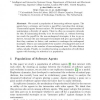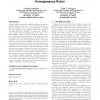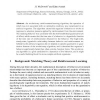28 search results - page 5 / 6 » Diversity as a selection pressure in dynamic environments |
GECCO
2009
Springer
14 years 3 months ago
2009
Springer
Embodied cognition emphasizes that intelligent behavior results from the coupled dynamics between an agent’s body, brain and environment. In response to this, several projects h...
ERCIMDL
2009
Springer
14 years 3 months ago
2009
Springer
We consider the problem of e-Infrastructures that wish to reconcile the generality of their services with the bespoke requirements of diverse user communities. We motivate the requ...
AAMAS
2002
Springer
13 years 8 months ago
2002
Springer
We control a population of interacting software agents. The agents have a strategy, and receive a payoff for executing that strategy. Unsuccessful agents become extinct. We investi...
GECCO
2009
Springer
14 years 3 months ago
2009
Springer
A central tenet of embodied artificial intelligence is that intelligent behavior arises out of the coupled dynamics between an agent’s body, brain and environment. It follows t...
ECAL
2005
Springer
14 years 2 months ago
2005
Springer
An evolutionary reinforcement-learning algorithm, the operation of which was not associated with an optimality condition, was instantiated in an artificial organism. The algorithm ...



